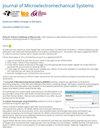TC f Manipulation in AlScN Nanomechanical Resonators Using Dual-Mode Parametric Excitation
IF 2.5
3区 工程技术
Q2 ENGINEERING, ELECTRICAL & ELECTRONIC
引用次数: 0
Abstract
In this work, we present resonator temperature coefficient of frequency (TCf) manipulation method by using the Duffing nonlinearities and non-dispersive coupling in two resonance modes within the same acoustic cavity. This temperature sensing technique leverages parametric pumping with a lock-in frequency, concurrently inducing signal and idler tones with opposite TCf signs. To demonstrate temperature sensing, aluminum scandium nitride (Al利用双模参数激励操纵 AlScN 纳米机械谐振器中的 TC$f$
在这项工作中,我们利用杜芬非线性和同一声腔内两个谐振模式的非分散耦合,提出了谐振器频率温度系数(TCf)操纵方法。这种温度传感技术利用锁定频率的参数泵浦,同时诱导出 TCf 符号相反的信号和惰音。为了演示温度传感,我们制作了具有两种共振振动模式(0,1)和(1,1)的氮化铝钪(Al $_{\mathrm {1-x}}$ ScxN)(x =0.2)鼓头纳米机械谐振器,并仔细研究了驱动共振模式和参数诱导模式的 TCf 趋势。实验测得的信号 TC $f_{1}$ 为 -178 ppm/K,惰性 TC $f_{2}$ 为 +88 ppm/K,且呈线性趋势,这是首次在具有负驱动模式 TCf 的谐振器上测得的正 TCf。 我们提出了一个一维整数参数模型,以阐明产生相反 TCf 符号的基本机制,该模型与测得的数据非常吻合。此外,我们还展示了通过节拍频率($f_{b}$)调制直接操纵 TCf 的方法,利用诱导信号及其谐波的内部混合,可以提高谐振系统的温度可调性。这项研究无需接口电子设备和双反馈回路,从而大大简化了谐振传感系统的系统级集成。[2024-0080]
本文章由计算机程序翻译,如有差异,请以英文原文为准。
求助全文
约1分钟内获得全文
求助全文
来源期刊

Journal of Microelectromechanical Systems
工程技术-工程:电子与电气
CiteScore
6.20
自引率
7.40%
发文量
115
审稿时长
7.5 months
期刊介绍:
The topics of interest include, but are not limited to: devices ranging in size from microns to millimeters, IC-compatible fabrication techniques, other fabrication techniques, measurement of micro phenomena, theoretical results, new materials and designs, micro actuators, micro robots, micro batteries, bearings, wear, reliability, electrical interconnections, micro telemanipulation, and standards appropriate to MEMS. Application examples and application oriented devices in fluidics, optics, bio-medical engineering, etc., are also of central interest.
 求助内容:
求助内容: 应助结果提醒方式:
应助结果提醒方式:


